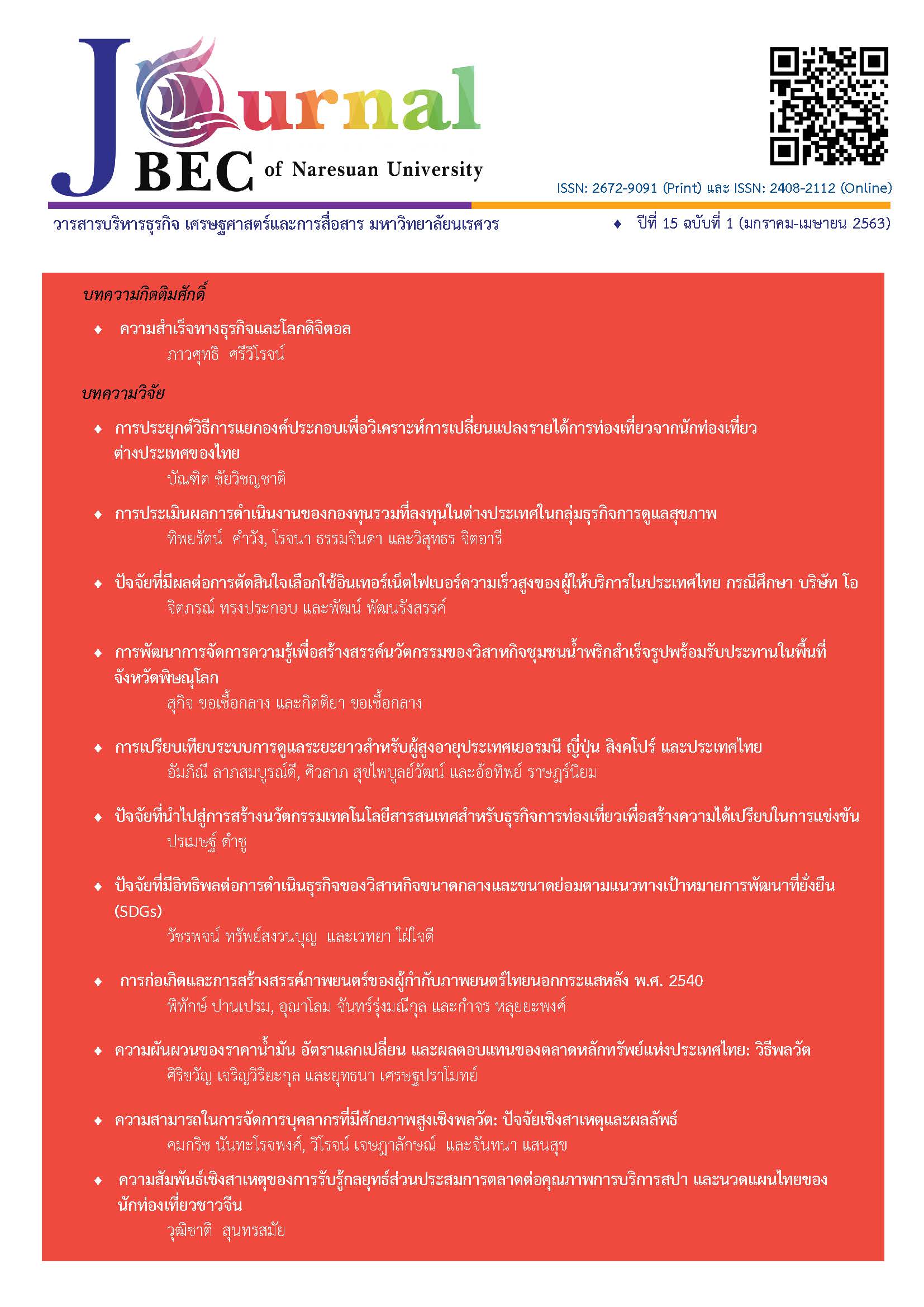ความผันผวนของราคาน้ามัน อัตราแลกเปลี่ยน และผลตอบแทนของตลาดหลักทรัพย์แห่งประเทศไทย: วิธีพลวัต
Main Article Content
บทคัดย่อ
บทคัดย่อ
การวิจัยในครั้งนี้มีวัตถุประสงค์เพื่อศึกษาความผันผวนของราคาน้ามัน และอัตราแลกเปลี่ยนที่มีผลกระทบต่อ
ผลตอบแทนของตลาดหลักทรัพย์แห่งประเทศไทย โดยใช้ข้อมูลรายสัปดาห์ของหลักทรัพย์ 8 กลุ่มอุตสาหกรรม ตั้งแต่มกราคม
2551 - พฤษภาคม 2561 ผลการศึกษาแบ่งได้เป็น 3 ส่วน คือ 1) ราคาน้ามันส่งผลกระทบต่อผลตอบแทนของหลักทรัพย์ทุกกลุ่ม
ในทิศทางเดียวกัน โดยจะกระทบกับกลุ่มทรัพยากร (Resources) มากที่สุด และกลุ่มเทคโนโลยี (Technology) น้อยที่สุด ส้าหรับ
ผลจากอัตราแลกเปลี่ยนพบว่า ส่งผลกระทบต่อผลตอบแทนของหลักทรัพย์ทุกกลุ่มในทิศทางตรงกันข้าม โดยจะกระทบกับกลุ่ม
ธุรกิจการเงิน (Financials) และกลุ่มทรัพยากร (Resources) มากที่สุด แต่จะกระทบกับกลุ่มเทคโนโลยี (Technology) น้อยที่สุด
2) ผลการทดสอบความผันผวนโดยใช้เครื่องมือทางเศรษฐมิติ (Generalised Autoregressive Conditional Heteroscedasticity:
GARCH) พบว่าในทุกกลุ่มหลักทรัพย์ความผันผวนของหลักทรัพย์ในอดีตส่งต่อผลตอบแทนของหลักทรัพย์มากกว่าเหตุการณ์ที่ไม่
สามารถคาดการณ์ได้ในอดีต 3) จากการศึกษาด้วยวิธีพลวัต (Dynamic Conditional Correlation: DCC) พบว่าคู่ของ
ความสัมพันธ์ระหว่างความผันผวนของราคาน้ามันและผลตอบแทนของตลาดหลักทรัพย์ทุกกลุ่มมีค่าสัมประสิทธิ์สหสัมพันธ์ใน
ทิศทางเดียวกัน ดังนั้นหากราคาน้ามันสูงขึ้น (ลดลง) จะส่งผลท้าให้อัตราผลตอบแทนของตลาดหลักทรัพย์เพิ่มขึ้น (ลดลง) ในขณะ
ที่ค่าสัมประสิทธิ์สหสัมพันธ์ระหว่างคู่ของความผันผวนของอัตราแลกเปลี่ยนและผลตอบแทนของตลาดหลักทรัพย์ทุกกลุ่มพบว่ามี
ทิศทางตรงกันข้าม สรุปได้ว่าหากค่าเงินบาทมีค่าอ่อนลง (แข็งค่า) จะส่งผลท้าให้ผลตอบแทนของตลาดหลักทรัพย์ลดลง (สูงขึ้น) ใน
ทุกกลุ่มหลักทรัพย์
Article Details
เอกสารอ้างอิง
Aongthong, A. (2007). A guide to using EViews program: For econometrics analysis. Chiangmai:
Social Research Insitution, Chiangmai University
Bahmani-Oskooee, M. and Saha, S. (2016). Asymmetry cointegration between the value of the dollar and sectoral stock indices in the US. International Review of Economics and Finance, 46, 78-86
Bai, S. and Koong, K. S. (2018). Oil prices, stock returns, and exchange rates: Empirical evidence from China and the United States. The North American Journal of Economics and Finance, 44(April 2018), 12-33.
Basher, S. A., Haug, A. A. and Sadorsky, P. (2012). Oil prices, exchange rates and emerging stock markets. Energy Economics, 34(1), 227-240.
Bastianin, A., Conti, F. and Manera, M. (2016). The impacts of oil price shocks on stock market volatility: Evidence from the G7 countries. Energy Policy, 98, 160-169.
Bollerslev, T. (1986). Generalized autoregressive conditional heteroskedasticity. Journal of Econometrics, 31(3), 307-327.
Delgado, N. A. B., Delgado, E. B. and Saucedo, E. (2018). The relationship between oil prices, the stock market and the exchange rate: evidence from Mexico. The North American Journal of Economics and Finance, 45(July 2018), 266-275.
Engle, R. (2002). Dynamic conditional correlation: A simple class of multivariate generalized autoregressive conditional heteroskedasticity models. Journal of Business and Economic Statistics, 20(3), 339-350.
Damodar, N. (2004). Basic econometrics. The Mc-Graw Hill. Jain, A. and Biswal, P. C. (2016). Dynamic linkages among oil price, gold price, exchange rate, and stock market in India. Resources Policy, 49(September 2016), 179-185.
Manager Online. (2018). Oil year '51, risking to step into crisis. Retrieved January 28, 2018, from https://mgronline.com/daily/detail/9500000155701
Matthaweewongsa, T., Teekasap, P., Tondee, T. and Teekasap, S. (2017). Foreign exchange and oil price exposure in Thai energy stocks. Journal of Renewable Energy and Smart Grid Technology, 12(1), 1-22.
Mollick, A. V. and Sakaki, H. (2019). Exchange rates, oil prices and world stock returns. Resources Policy, 61(June 2019), 585-602.
Moore, T. and Wang, P. (2014). Dynamic linkage between real exchange rates and stock prices: Evidence from developed and emerging Asian markets. International Review of Economics and Finance, 29(January 2014), 1-11.
Sikhosana, A. and Goodness C. A. (2018). Asymmetric volatility transmission between the real exchange rate and stock eturns in South Africa. Economic Analysis and Policy, 60(December 2018), 1-8.
Tule, M., Dogo, M. and Uzonwanne, G. (2018). Volatility of stock market returns and the naira exchange rate. Global Finance Journal, 35(February 2018), 97-105.
Yang, L., Cai, X. J. and Hamori, S. (2018). What determines the long-term correlation between oil prices and exchange rates?. The North American Journal of Economics and Finance, 44(April 2018), 140-152.


